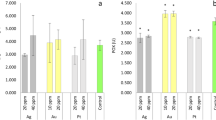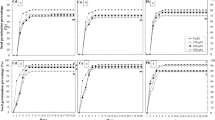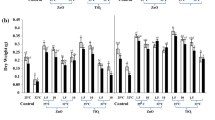Abstract
This study investigated the physiological and biochemical impacts of organophosphate flame retardants (OPFRs) on wheat (Triticum aestivum L.) germination and growth performance in the presence and absence of copper. The study evaluated seed germination, growth, OPFRs concentrations, chlorophyll fluorescence index (Fv/Fm and Fv/F0), and antioxidant enzyme activity. It also calculated the root accumulation of OPFRs and their root-stem translocation. At the germination stage, at a concentration of 20 μg·L−1 OPFR exposure, wheat germination vigor, root, and shoot lengths were significantly decreased compared to the control. However, the addition of a high concentration of copper (60 mg·L−1) decreased by 80%, 82%, and 87% in the seed germination vitality index and root and shoot elongation, respectively, compared to 20 μg·L−1 of OPFR treatment. At the seedling stage, a concentration of 50 μg·L−1 of OPFRs significantly decreased by 42% and 5.4% in wheat growth weight and the photochemical efficiency of photosystem II (Fv/Fm) compared to the control. However, the addition of a low concentration of copper (15 mg·L−1) slightly enhanced the growth weight compared to the other two co-exposure treatments, but the results were not significant (p > 0.05). After 7 days of exposure, the activity of superoxide dismutase (SOD) and malondialdehyde (MDA) (indicates lipid peroxidation) content in wheat roots significantly increased compared to the control and was higher than in leaves. MDA contents in wheat roots and shoots were decreased by 18% and 6.5% when OPFRs were combined with low Cu treatment compared with single OPFRs treatment, but SOD activity was slightly improved. These results suggest that the co-exposure of copper and OPFRs enhances reactive oxygen species (ROS) production and oxidative stress tolerance. Seven OPFRs were detected in wheat roots and stems, with root concentration factors (RCFs) and translocation factors (TFs) ranging from 67 to 337 and 0.05 to 0.33, respectively, for the seven OPFRs in a single OPFR treatment. The addition of copper significantly increased OPFR accumulation in the root and aerial parts. In general, the addition of a low concentration of copper promoted wheat seedling elongation and biomass and did not significantly inhibit the germination process. OPFRs could mitigate the toxicity of low-concentration copper on wheat but had a weak detoxification effect on high-concentration copper. These results indicated that the combined toxicity of OPFRs and Cu had antagonistic effects on the early development and growth of wheat.






Similar content being viewed by others
Availability of data and materials
All data generated or analyzed in this study are included in this manuscript and in the published articles.
References
Abdelgawad H, Zinta G, Badreldin AH, Selim S, Abuelsoud W (2019) Maize roots and shoots show distinct profiles of oxidative stress and antioxidant defense under heavy metal toxicity. Environ Pollut 258:113705. https://doi.org/10.1016/j.envpol.2019.113705
Ambrosini VG, Rosa DJ, Bastos de Melo GW, Zalamena J, Cella C, Simão DG, Souza da Silva L, Pessoa dos Santos H, Toselli M, Tiecher TL, Brunetto G (2018) High copper content in vineyard soils promotes modifications in photosynthetic parameters and morphological changes in the root system of ‘Red Niagara’ plantlets. Plant Physiol Biochem 128:89–98. https://doi.org/10.1016/j.plaphy.2018.05.011
Bae J, Benoit DL, Watson AK (2016) Effect of heavy metals on seed germination and seedling growth of common ragweed and roadside ground cover legumes. Environ Pollut 213:112–118
Bao Y, Pan C, Li D, Guo A, Dai F (2022) Stress response to oxytetracycline and microplastic-polyethylene in wheat (Triticum aestivum L.) during seed germination and seedling growth stages. Sci Total Environ 806. https://doi.org/10.1016/J.SCITOTENV.2021.150553
Bonato T, Beggio G, Pivato A, Piazza R (2022) Maize plant (Zea mays) uptake of organophosphorus and novel brominated flame retardants from hydroponic cultures. Chemosphere 287. https://doi.org/10.1016/j.chemosphere.2021.132456
Chen J, Xia X, Chu SQ, Wang H, Gan JJ (2020) Cation-π interactions with coexisting heavy metals enhanced the uptake and accumulation of polycyclic aromatic hydrocarbons in spinach. Environ Sci Technol 54(12):7261–7270. https://doi.org/10.1021/acs.est.0c00363
Chen X, Zhao X, Shi Z (2021) Organophosphorus flame retardants in breast milk from Beijing, China: occurrence, nursing infant’s exposure and risk assessment. Sci Total Environ 771. https://doi.org/10.1016/j.scitotenv.2021.145404
Deng S, Ke T, Wu Y, Zhang C, Hu Z, Yin H, Guo L, Chen L, Zhang D (2018) Heavy Metal Exposure alters the uptake behavior of 16 priority polycyclic aromatic hydrocarbons (PAHs) by pak choi (Brassica chinensis L.). Environ Sci Technol 52:13457–13468. https://doi.org/10.1021/acs.est.8b01405
Du J, Li H, Xu S, Zhou Q, Jin M, Tang J (2019) A review of organophosphorus flame retardants (OPFRs): occurrence, bioaccumulation, toxicity, and organism exposure. Environ Sci Pollut Res 26:22126–22136. https://doi.org/10.1007/s11356-019-05669-y
Garcia-Garin O, Sala B, Aguilar A, Vighi M, Víkingsson GA, Chosson V, Eljarrat E, Borrell A (2020) Organophosphate contaminants in North Atlantic fin whales. Sci Total Environ 721. https://doi.org/10.1016/j.scitotenv.2020.137768
Gong X, Wang Y, Pu J, Zhang J, Sun H, Wang L (2020) The environment behavior of organophosphate esters (OPEs) and di-esters in wheat (Triticum aestivum L.): uptake mechanism, in vivo hydrolysis and subcellular distribution. Environ Int 135. https://doi.org/10.1016/j.envint.2019.105405
He C-T, Zheng J, Qiao L, Chen S-J, Yang J-Z, Yuan J-G, Yang Z-Y, Mai B-X (2015) Occurrence of organophosphorus flame retardants in indoor dust in multiple microenvironments of southern China and implications for human exposure. Chemosphere 133:47–52. https://doi.org/10.1016/j.chemosphere.2015.03.043
He J, Wang Z, Zhao L, Ma H, Huang J, Li H, Mao X, Huang T, Gao H, Ma J (2021) Gridded emission inventory of organophosphorus flame retardants in China and inventory validation. Environ Pollut 290. https://doi.org/10.1016/j.envpol.2021.118071
Hou R, Xu Y, Wang Z (2016) Review of OPFRs in animals and humans: absorption, bioaccumulation, metabolism, and internal exposure research. Chemosphere 153:78–90. https://doi.org/10.1016/j.chemosphere.2016.03.003
Hu B, Jiang L, Zheng Q, Luo C, Zhang D, Wang S, Xie Y, Zhang G (2021) Uptake and translocation of organophosphate esters by plants: impacts of chemical structure, plant cultivar and copper. Environ Int 155. https://doi.org/10.1016/j.envint.2021.106591
Hu Y-X, Sun Y-X, Li X, Xu W-H, Zhang Y, Luo X-J, Dai S-H, Xu X-R, Mai B-X (2017) Organophosphorus flame retardants in mangrove sediments from the Pearl River Estuary, South China. Chemosphere 181:433–439. https://doi.org/10.1016/j.chemosphere.2017.04.117
Ji Y, Wang Y, Yao Y, Ren C, Lan Z, Fang X, Zhang K, Sun W, Alder AC, Sun H (2019) Occurrence of organophosphate flame retardants in farmland soils from Northern China: primary source analysis and risk assessment. Environ Pollut 247:832–838. https://doi.org/10.1016/j.envpol.2019.01.036
Lin MZ, Jin MF (2018) Soil Cu contamination destroys the photosynthetic systems and hampers the growth of green vegetables. Photosynthetica 56:1336–1345. https://doi.org/10.1007/s11099-018-0831-7
Liu Q, Tang X, Jian X, Yang Y, Ma W, Wang Y, Zhang X (2020) Toxic effect and mechanism of tris (1,3-dichloro-2-propyl)phosphate (TDCPP) on the marine alga Phaeodactylum tricornutum. Chemosphere 252. https://doi.org/10.1016/j.chemosphere.2020.126467
Liu Q, Wang X, Yang R, Yang L, Sun B, Zhu L (2019) Uptake kinetics, accumulation, and long-distance transport of organophosphate esters in plants: impacts of chemical and plant properties. Environ Sci Technol 53:4940–4947. https://doi.org/10.1021/acs.est.8b07189
Luo Q, Li Y, Wu Z, Wang X, Wang C, Shan Y, Sun L (2021) Phytotoxicity of tris-(1-chloro-2-propyl) phosphate in soil and its uptake and accumulation by pakchoi (Brassica chinensis L. cv. SuZhou). Chemosphere 277. https://doi.org/10.1016/j.chemosphere.2021.130347
Madejón P, Ramírez-Benítez JE, Corrales I, Barceló J, Poschenrieder C (2009) Copper-induced oxidative damage and enhanced antioxidant defenses in the root apex of maize cultivars differing in Cu tolerance. Environ Exp Bot 67:415–420. https://doi.org/10.1016/j.envexpbot.2009.08.006
McGoldrick DJ, Letcher RJ, Barresi E, Keir MJ, Small J, Clark MG, Sverko E, Backus SM (2014) Organophosphate flame retardants and organosiloxanes in predatory freshwater fish from locations across Canada. Environ Pollut 193:254–261. https://doi.org/10.1016/j.envpol.2014.06.024
Picó Y, Campo J, Alfarhan AH, El-Sheikh MA, Barceló D (2021) A reconnaissance study of pharmaceuticals, pesticides, perfluoroalkyl substances and organophosphorus flame retardants in the aquatic environment, wild plants and vegetables of two Saudi Arabia urban areas: environmental and human health risk assessment. Sci Total Environ 776. https://doi.org/10.1016/j.scitotenv.2021.145843
Pilon M, Abdel-Ghany SE, Cohu CM, Gogolin KA, Ye H (2006) Copper cofactor delivery in plant cells. Curr Opin Plant Biol 9:256–263. https://doi.org/10.1016/j.pbi.2006.03.007
Ranal MA, Santana DG, Ferreira WR, Mendes-Rodrigues C (2009) Calculating germination measurements and organizing spreadsheets. Brazilian. Journal of Botany 32(4). https://doi.org/10.1590/S0100-84042009000400022
Santín G, Eljarrat E, Barceló D (2016) Simultaneous determination of 16 organophosphorus flame retardants and plasticizers in fish by liquid chromatography-tandem mass spectrometry. J Chromatogr A 1441:34–43. https://doi.org/10.1016/j.chroma.2016.02.058
Wan W, Huang H, Lv J, Han R, Zhang S (2017) Uptake, translocation, and biotransformation of organophosphorus esters in wheat (Triticum aestivum L.). Environ Sci Technol 51:13649–13658. https://doi.org/10.1021/acs.est.7b01758
Wan W, Zhang S, Huang H, Wu T (2016) Occurrence and distribution of organophosphorus esters in soils and wheat plants in a plastic waste treatment area in China. Environ Pollut 214:349–353. https://doi.org/10.1016/j.envpol.2016.04.038
Wang H, Tang X, Sha J, Chen H, Sun T, Wang Y (2015a) The reproductive toxicity on the rotifer Brachionus plicatilis induced by BDE-47 and studies on the effective mechanism based on antioxidant defense system changes. Chemosphere 135:129–137. https://doi.org/10.1016/j.chemosphere.2015.03.090
Wang L-M, Luo D, Li X, Hu L-Q, Chen J-X, Tu Z-Z, Sun B, Chen H-G, Liu L, Yu M, Li Y-P, Pan A, Messerlian C, Mei S-R, Wang Y-X (2021a) Temporal variability of organophosphate flame retardant metabolites in spot, first morning, and 24-h urine samples among healthy adults. Environ Res 196. https://doi.org/10.1016/j.envres.2020.110373
Wang S-c, Gao Z-Y, Liu F-F, Chen S-Q, Liu G-Z (2021b) Effects of polystyrene and triphenyl phosphate on growth, photosynthesis and oxidative stress of Chaetoceros meülleri. Sci Total Environ 797. https://doi.org/10.1016/j.scitotenv.2021.149180
Wang S, Wang Y, Luo C, Jiang L, Song M, Zhang D, Wang Y, Zhang G (2015b) Could uptake and acropetal translocation of PBDEs by corn be enhanced following cu exposure? Evidence from a root damage experiment. Environ Sci Technol 50:856–863. https://doi.org/10.1021/acs.est.5b04030
Wang Y, Li Z, Tan F, Xu Y, Zhao H, Chen J (2020) Occurrence and air-soil exchange of organophosphate flame retardants in the air and soil of Dalian, China. Environ Pollut 265. https://doi.org/10.1016/j.envpol.2020.114850
Wani PA, Khan MS, Zaidi A (2012) Toxic effects of heavy metals on germination and physiological processes of plants. Springer, Vienna. https://doi.org/10.1007/978-3-7091-0730-0_3
Xu Y, Yu W, Ma Q, Zhou H, Jiang C (2017) Toxicity of sulfadiazine and copper and their interaction to wheat ( Triticum aestivum L.) seedlings. Ecotoxicol Environ Saf 142:250–256. https://doi.org/10.1016/j.ecoenv.2017.04.007
Yan Z, Jin X, Liu D, Hong Y, Liao W, Feng C, Bai Y (2021) The potential connections of adverse outcome pathways with the hazard identifications of typical organophosphate esters based on toxicity mechanisms. Chemosphere 266. https://doi.org/10.1016/j.chemosphere.2020.128989
Zhang L, Wang Q, Chen H, Yao Y, Sun H (2021a) Uptake and translocation of perfluoroalkyl acids with different carbon chain lengths (C2–C8) in wheat (Triticum acstivnm L.) under the effect of copper exposure. Environ Pollut 274. https://doi.org/10.1016/j.envpol.2021.116550
Zhang Q, Yao Y, Wang Y, Zhang Q, Cheng Z, Li Y, Yang X, Wang L, Sun H (2021b) Plant accumulation and transformation of brominated and organophosphate flame retardants: a review. Environ Pollut 288. https://doi.org/10.1016/j.envpol.2021.117742
Zhang W, Wang H, Bai Q, Li X (2022a) Lipocalin-mediated organophosphate esters (OPEs) active uptake and accumulation in rice (Oryza sativa L.). Environ Exp Bot 200. https://doi.org/10.1016/j.envexpbot.2022.104910
Zhang X, Ai S, Wei J, Yang X, Huang Y, Hu J, Wang Q, Wang H (2022b) Biphasic effects of typical chlorinated organophosphorus flame retardants on Microcystis aeruginosa. Ecotoxicol Environ Saf 241. https://doi.org/10.1016/j.ecoenv.2022.113813
Acknowledgements
We thank the reviewers and the editor; their comments greatly improved the initial draft of this manuscript.
Funding
This work was financially supported by the National Natural Science Foundation of China (Nos .22076134, 21876125, and 41807142) and the Graduate Research & Practice Innovation Program of Jiangsu Province (SJCX21_1398).
Author information
Authors and Affiliations
Contributions
DXD proposed the idea of research and experimental design and wrote the original draft. SJX and YYS contributed to figures and tables. JXW, GYS, XDW, and HLW provided a critical review and substantially revised the manuscript. All authors read and approved the final manuscript.
Corresponding author
Ethics declarations
Ethical approval
Not applicable.
Consent to participate
Not applicable.
Consent for publication
Our results presented in this study have not been published before, nor have they been published elsewhere.
Competing interests
The authors declare no competing interests.
Additional information
Responsible Editor: Gangrong Shi
Publisher’s note
Springer Nature remains neutral with regard to jurisdictional claims in published maps and institutional affiliations.
Supplementary information
ESM 1:
Tables S1–S4 (DOCX 88 kb)
Rights and permissions
Springer Nature or its licensor (e.g. a society or other partner) holds exclusive rights to this article under a publishing agreement with the author(s) or other rightsholder(s); author self-archiving of the accepted manuscript version of this article is solely governed by the terms of such publishing agreement and applicable law.
About this article
Cite this article
Deng, D., Wang, J., Xu, S. et al. The physiological effect of organophosphate flame retardants (OPFRs) on wheat (Triticum aestivum L.) seed germination and seedling growth under the presence of copper. Environ Sci Pollut Res 30, 70109–70120 (2023). https://doi.org/10.1007/s11356-023-27312-7
Received:
Accepted:
Published:
Issue Date:
DOI: https://doi.org/10.1007/s11356-023-27312-7




